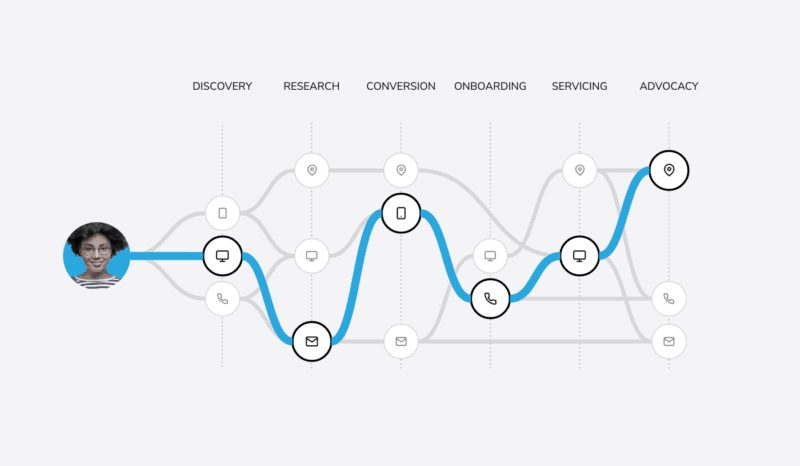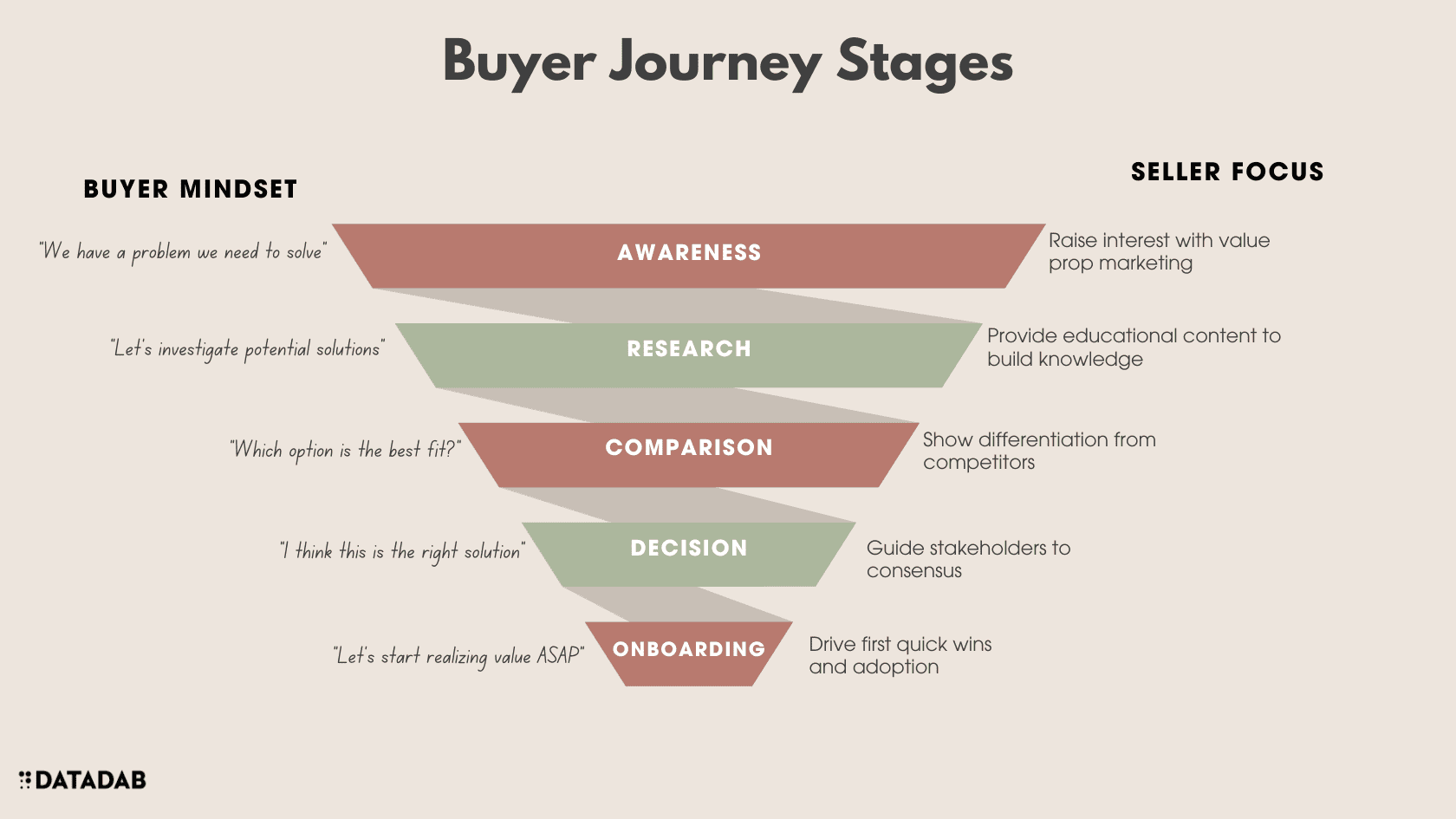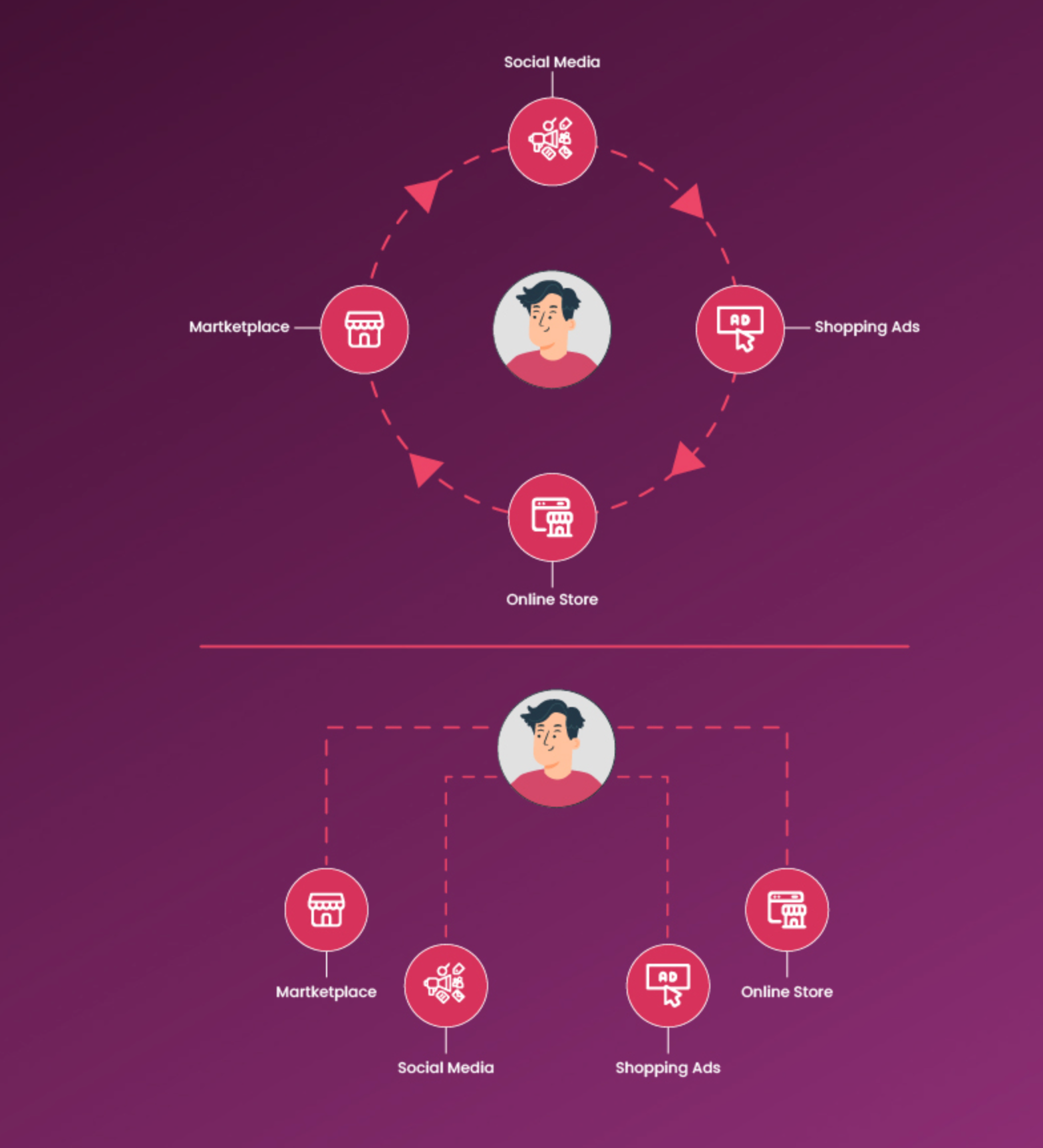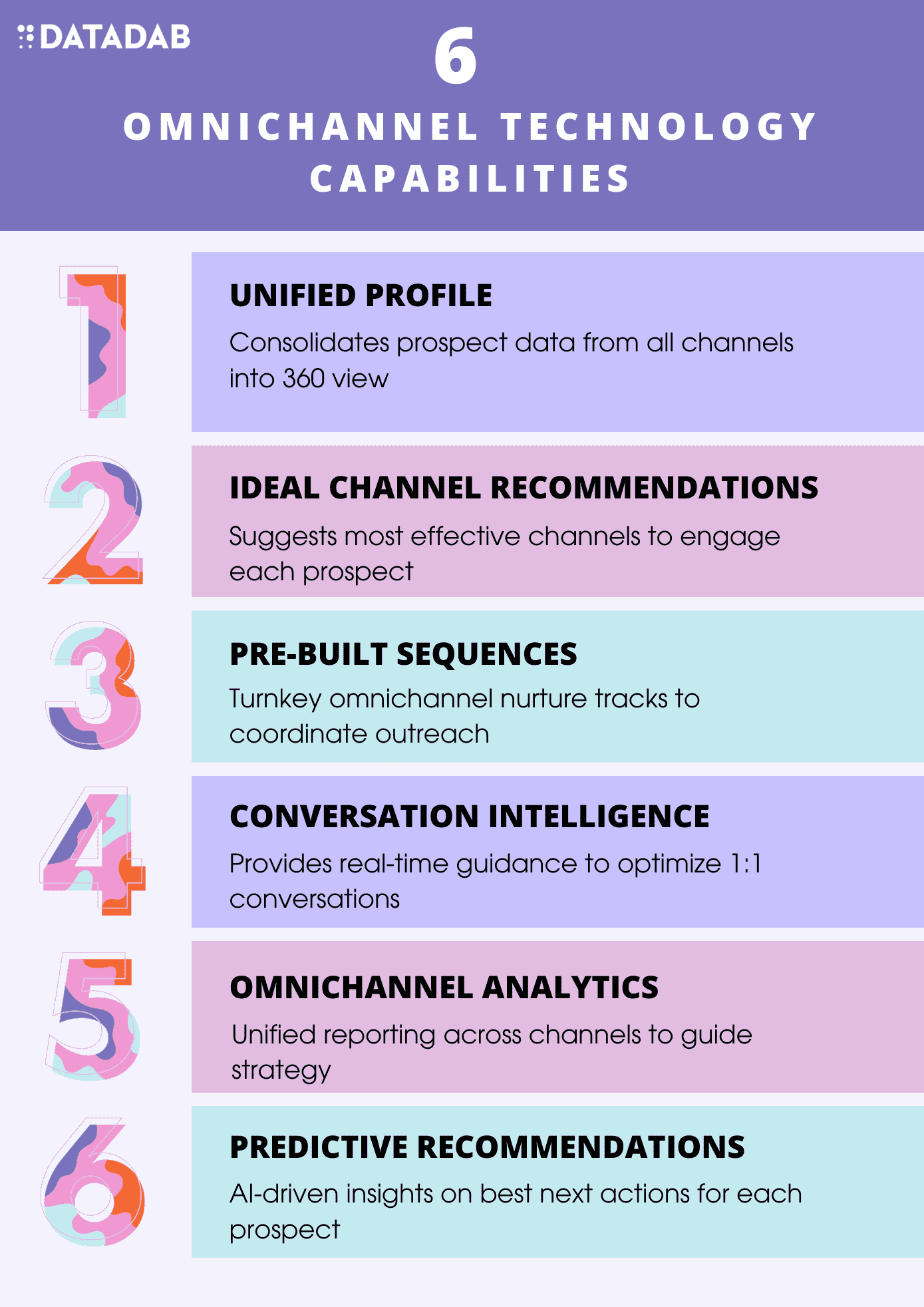“Omnichannel selling is not just a sales strategy, it’s a philosophy focused on engaging prospects in meaningful dialogues tailored to their needs.”
Selling is harder than ever before. Customers expect personalized attention across every channel - email, phone, social media, you name it. Juggling all these channels leaves sales teams overwhelmed and missing opportunities.
But it doesn't have to be this way. New sales enablement platforms use technology to coordinate omnichannel selling, so reps can focus on building relationships. These tools are game changers for connecting with customers.
In this post, I'll share how sales enablement software empowers teams to orchestrate context-driven omnichannel plays tailored to each buyer’s needs and preferences. I'll cover real-world examples of omnichannel selling in action, key capabilities to look for in enablement platforms, and tips for rolling out new technology.

By the end, you’ll see why savvy sales leaders are making omnichannel coordination core to their customer engagement strategies. Let’s dive in!
Challenges Sales Teams Face
Without a consolidated view of prospect profiles and engagement history, selling teams operate in the dark. Manual attempts to track buyer signals are not scalable as contact volumes and channels continue expanding exponentially. Enablement platforms provide welcome relief for these pains.
Let's examine some of the core challenges sales organizations face that hinder omnichannel execution:
Data in disparate systems
Sales reps struggle to build unified prospect profiles and engagement history across marketing, sales, and CRM systems. This results in fragmented views.
Lack of transparency into digital body language
Buyer signals like website engagement and content downloads often happen anonymously, limiting seller visibility into prospect interest and intent.
Complex chore of multichannel coordination
Orchestrating coordinated outreach across channels is manual and time-consuming without predefined sequenced plays.
No guidance on ideal prospect-channel fit
Determining the right channels to engage each prospect is challenging without data-driven recommendations.
Ineffective 1:1 conversations
Reps lack prompts on talking points and content tailored to the prospect's context during calls and meetings.
No insight into engagement impact
With limited analytics on multichannel activity, sellers can't prioritize actions or optimize strategies.
These gaps make it incredibly difficult for sales teams to deliver synchronized omnichannel experiences. How can you help them overcome these hurdles?

How Enablement Platforms Empower Omnichannel Orchestration
Enablement suites integrate previously disconnected systems into unified hubs for managing prospect interactions. Built-in analytics spotlight opportunities while AI capabilities guide next best actions per buyer. The future of selling is orchestration - and it’s here now.

Sales enablement technology provides the infrastructure sales teams need to excel at omnichannel selling. Here are the key capabilities your platform should deliver:
360 Prospect Profiles
Unify data from all systems into comprehensive buyer profiles. Provide the complete picture.
| Prospect 360 | Details |
|---|---|
| Contacts | Main stakeholders involved in buying process |
| Firmographics | Company size, industry, tech stack |
| Buying center | All influencers and decision makers identified |
| Digital body language | Site visits, content downloads, email engagement |
| Intent data | Identified needs and interests based on search and browsing |
| Engagement history | Meetings, emails, chat conversations logged |
| Persona traits | Motivations, challenges, and preferences |
Ideal Channel Recommendations
Analyze engagement data to recommend the right channels to engage each prospect for maximum response. Help prioritize seller effort.
Pre-Built Omnichannel Plays
Provide turnkey sequenced nurture tracks with coordinated multichannel actions mapped to the buyer's journey. Eliminate chore of manual coordination.
Contextual Conversation Intelligence
Arm reps with relevant talking points and content recommendations for calls and meetings based on the prospect's profile and engagement history. Optimize 1:1 interactions.
Omnichannel Activity Tracking
Log all sales activities across channels in one place. Analyze performance trends to refine strategies. Give managers visibility into team effectiveness.
With these capabilities powered by your platform, sales reps gain the visibility, intelligence, and orchestration required for context-driven omnichannel selling.
Now let's explore how this translates to impactful omnichannel scenarios.

Omnichannel Selling in Action
Seamless hand-offs between channels tailored to prospect preferences - this is the holy grail sellers now have in their grasp thanks to intelligent enablement tools. Prescriptive recommendations and automated multichannel coordination free up human reps to focus on building meaningful customer relationships.
Imagine a sales rep named Michael who is engaging with Sarah, a Director of Operations at a mid-sized tech company.
Here's how Michael orchestrates omnichannel outreach with your enablement platform:
- The platform captures Sarah's anonymous website visits and content downloads
- With her digital body language revealed, Michael sends a personalized outreach email
- When Sarah opens but doesn't click, the platform recommends a LinkedIn InMail as the ideal next channel
- Michael sends an InMail referencing the content she read to start a conversation
- Sarah responds, so Michael schedules a call guided by talk tracks and assets recommended by your platform
- After an effective call, Michael sends a follow-up email with a relevant case study
- Given positive engagement across channels, Michael sends a calendar invite to give a demo
- Michael delivers an impressive demo customized to Sarah's use cases based on previous conversations and profile
By coordinating each step and optimizing based on intelligence within your enablement platform, Michael provided Sarah with a tailored omnichannel journey ultimately leading to a demo.
This is just one example of the omnichannel scenarios your technology enables, leading to more meaningful prospect engagements and faster sales cycles.

Promoting Omnichannel Success
Getting sales teams bought into new technology for orchestrating omnichannel takes savvy change management. Leadership must clearly communicate priorities while demonstrating quick wins. With the right messaging and incentives, enablement platform adoption can dramatically transform sales execution.
As a sales enablement leader, how can you promote your platform as the key to omnichannel orchestration?
Educate on buyer expectations
Create assets highlighting research on buyers' preferences for seamless omnichannel experiences. Increase urgency to adopt an orchestrated approach.
Showcase client success stories
Collect and promote case studies of customers excelling at omnichannel selling with your solution. Prove real-world value.
Demonstrate ease of getting started
Show quick time-to-value with pre-built sequences, integrations, and omnichannel analytics requiring minimal ramp up and config.
Share risk-free trials
Offer free trials and pilots that allow teams to test omnichannel capabilities first-hand without commitment. Let the platform sell itself.
Highlight SMB-friendly packages
For smaller teams, provide affordable packages with essential orchestration elements without enterprise complexity or costs. Expand your market reach.
Publish educational content
Develop videos, blogs, and guides that provide tactical advice on orchestrating contextual omnichannel selling. Become a trusted advisor.
Following these best practices will organically grow awareness of how your sales enablement solution powers successful omnichannel strategies. Now is the time to help teams meet the challenges of modern selling.
Key Takeaways
Here are some of the core recommendations covered in this guide:
- Educate sales teams on why omnichannel selling is critical to connect with today's buyers
- Promote enablement platforms as providing the crucial data, intelligence, and coordination for omnichannel success
- Highlight specific use cases and capabilities that empower teams to orchestrate contextual cross-channel interactions
- Generate awareness through customer success stories, trials, and educational content
- Tailor packages and pricing to serve organizations of all sizes
With the right messaging and enablement technology, you can help sales teams rise to the challenges posed by the omnichannel imperative. This will strengthen customer relationships, increase sales productivity, and ultimately drive revenue growth.
The selling landscape will only grow more complex across channels. Start enabling success today.
FAQ
1. Why is omnichannel selling important?
Omnichannel selling is critical for three core reasons:
- Buyer expectations - Today's buyers expect ultra-personalized, seamless experiences across channels. Siloed, channel-specific outreach no longer meets their standards.
- More touchpoints - With new channels constantly emerging, buyers now engage across far more touchpoints in their journey. Sellers must adapt to this more complex landscape.
- Business impact - Companies who adopt integrated omnichannel selling enjoy 46% higher win rates according to Forrester research. It drives faster deals, higher revenue, and deeper customer relationships when done well.
In summary, omnichannel is vital to deliver the excellent buying experiences buyers demand while improving sales effectiveness. It's now table stakes for sales success.
2. How does omnichannel differ from multichannel selling?
The core distinction is:
- Multichannel - Engaging buyers through different channels, but in an uncoordinated, siloed way. Channels operate independently.
- Omnichannel - Orchestrating a sequenced, integrated experience across channels personalized to buyer needs. Channels work together harmoniously.
In omnichannel, channels are leveraged synergistically to advance prospects step-by-step based on historical interactions and profile. In multichannel, channels work in isolation, often leading to fragmented or repetitive outreach.
3. What channels should be included in an omnichannel sales strategy?
While omnichannel isn't limited to any fixed set of channels, most sales organizations focus orchestration across these core channels:
- Email - Primary workhorse channel for consistent nurturing
- Calls/video - Key to real-time dialogue and relationship building
- In-person meetings - Allow for deeper conversations and relationship building
- Social selling - Humanizes brand and enables 1:1 conversations
- Website/chat - Captures early-stage interest and intent signals
- Events - Opportunity for valuable face time in an engaging setting
- Direct mail - Combats email fatigue for specific touches
- SMS - Immediate channel often read quickly
As you build your omnichannel approach, concentrate efforts on the channels your buyers respond to best. Expand from there based on what will resonate most with your audience.
4. What does a typical omnichannel scenario look like?
Here's an example omnichannel sequence:
- Email #1 - Send educational content like an e-book relevant to buyer pains
- Call/video - Discuss content and dig into needs uncovered during prospecting
- Email #2 - Share 3rd party report with compelling data based on call insights
- In-person meeting - Provide demo showing how you address needs identified in earlier interactions
- Social outreach - Share customer success content that relates to their scenario
- Email #3 - Position proposal detailing value specific to their requirements
This provides an overview of orchestrating complementary touches over time that position your solution in relation to the prospect's situational needs. Each step builds on the previous interactions to advance the relationship.
5. What are some best practices for execution?
Some top omnichannel best practices include:
- Map buyer journeys - Understand the typical stages and channels resonating for each persona.
- Leverage intent data - Incorporate anonymous signals like web activity into outreach triggers.
- Build in flexibility - Allow sales reps freedom to use their judgment on right plays.
- Focus on seamlessness - Eliminate any gaps between channels through tight integration.
- Coordinate across departments - Align sales, marketing, and customer success.
- Test and refine - Continuously experiment with new sequences and optimize based on feedback.
- Enable mobile - Support reps engaging prospects seamlessly via mobile.
- Track performance - Analyze metrics by channel to guide future strategies and investment.
The keys are understanding your audience, enabling flexible coordination across silos, and continuously improving through iteration and data.
6. What technology is required to support omnichannel selling?
Core technologies enabling omnichannel include:
- CRM - Central database capturing all prospect/customer information and interactions.
- Marketing automation - Nurtures prospects via tailored content across channels.
- Sales enablement - Provides intelligence to optimize outreach and engagement.
- Analytics - Reports on channel and program performance to refine approach.
- Interaction capture - Records calls, video, chat to analyze engagement patterns.
- Digital body language tracking - Captures anonymous web activity signals indicative of interest.
- Intent monitoring - Surfaces prospects demonstrating early research behavior.
With the right martech stack, sales teams can deliver unified buying experiences personalized to each prospect's needs and preferences.
7. How can companies with limited resources adopt omnichannel?
For resource-constrained teams, focus on a “minimum viable” omnichannel approach:
- Coordinate core channels - Orchestrate key channels like email, phone/video, and CRM first.
- Leverage martech building blocks- Many platforms offer packaged solutions to automate workflows across channels. Build on these capabilities.
- Equip reps for 1:1 interactions - Provide guidelines, content recommendations, and conversation guides to optimize human interactions.
- Analyze channel metrics - Review reports on channel contribution and velocity to guide investment.
- Experiment - Test orchestrated sequences on small groups of accounts and refine over time.
The goal is to make incremental progress - not boil the ocean. With a pragmatic approach, even smaller teams can improve omnichannel maturity over time.
8. How long does it take to implement an omnichannel sales strategy?
For most organizations, building mature omnichannel capabilities takes 6–12 months. Key phases include:
1–2 Months: Planning
- Document buyer journeys
- Audit existing tactics/tools
- Build business case
- Form a cross-functional team
3 Months: Infrastructure Setup
- Select & implement new technology
- Integrate platforms
- Develop unified data foundation
2–3 Months: Execution
- Design sequences and plays
- Train reps on new processes
- Enable sales tools/coaching
Ongoing: Optimization
- Launch small pilots
- Analyze data and refine
- Expand use cases
- Report on omnichannel KPIs
This provides a rough timeline - but focus on iterating based on continuous feedback rather than arbitrary timelines. Gains can happen much faster via an agile approach.
9. How can you demonstrate the business impact of omnichannel?
Important omnichannel metrics to track include:
- Channel contribution - % of pipeline generated by each channel
- Channel velocity - Average sales cycle time by channel
- Omnichannel conversion rates - Win rates for multichannel prospects
- Channel engagement efficiency - Pipeline yield per marketing investment by channel
These metrics quantify how different channels work together to create opportunities, accelerate deals, and influence revenue. Trending metrics over time illustrates the progress driven by omnichannel orchestration.
Surveys can also capture helpful anecdotal data on buyer satisfaction with omnichannel experiences.
10. What does the future hold for omnichannel sales?
Looking ahead, omnichannel will only grow more important as buyers engage across more touchpoints. Key innovations on the horizon include:
- Content personalization - Matching content dynamically to prospect needs
- Predictive recommendations - AI suggesting best next actions per prospect
- Expanded channel integration - Orchestrating emerging channels like chat, paid media
- Mobile optimization - Contextual guidance for reps on-the-go
- Impact measurement - Deeper analytics into channel influence
- Omnichannel account planning - Coordinating engagement across buying centers
- Omnichannel advertising - Integrating digital/traditional advertising with sales
As technology improves, omnichannel will evolve from broad coordination to highly personalized, predictive interactions optimized in real-time. Sales teams must continue advancing capabilities to deliver standout buyer experiences.
Omnichannel mastery will be a key competitive differentiator for sales organizations going forward. Now is the time to build these competencies.







